"Something is happening to the way people live" opined Nanna Ditzel in 1961; changing realities which caused her to reflect that, in terms of our furniture and interiors, "don't we carry around a whole load of stuff that is old and defunct - and could actually be different."1
With the exhibition Nanna Ditzel. Taking Design to New Heights, Trapholt, Kolding, explore how Nanna Ditzel approached and understood and realised that "different".......
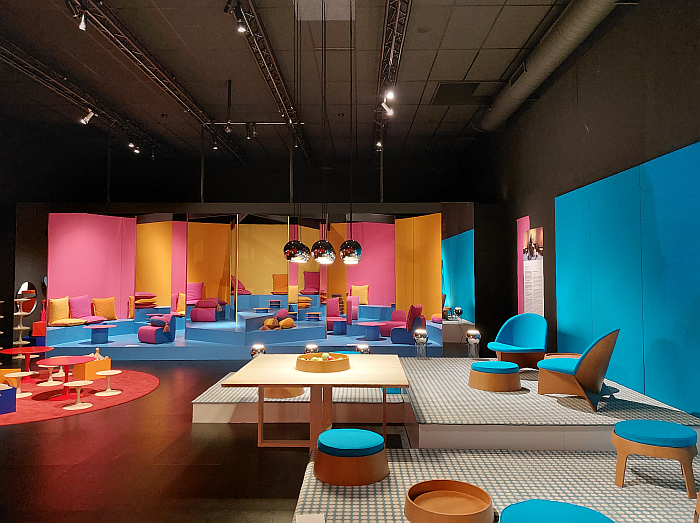
Born in Copenhagen on October 6th 1923 Nanna Hauberg graduated from Aurehøj Gymnasium, Gentofte, in 1942 and in the same year began an apprenticeship at the Richards Skole, Copenhagen, simultaneously attending evening classes at the city's Technical College before in 1943 enrolling at the Kunsthåndværkerskolen, Arts and Crafts College, Copenhagen, and, more or less parallel, attending Kaare Klint's classes at that high bastion of furniture design education in 20th century Denmark, the Kongelige Danske Kunstakademi. In how far Nanna Hauberg was actually a formally registered student at the Kunstakademi, we're unsure; alone we know that she graduated from the Kunsthåndværkerskolen in 1946. And that at the Kunsthåndværkerskolen she met Jørgen Ditzel, the pair marrying in 1946 and simultaneously establishing a joint professional practice; the Ditzels' home and studio being based from 1949 in the Bagsværd district on the northern edge of the Danish capital. A base from where in addition to regularly exhibiting at the fabled Copenhagen Cabinetmakers Guild Exhibition, and developing installations for other exhibitions, the Ditzels also launched furniture projects with manufacturers such as, for example, Kolds Savværk, Kvist Møbler or Fredericia Furniture. And a period which also saw Nanna Ditzel begin jewellery design, a step initially taken, as she recalls, because she was at home with young children and needed something to do, but which became a very important pillar of her oeuvre.
Then in 1961 Jørgen died, aged just 39, and Nanna Ditzel, alone in Bagsværd with three young children, continued the practice on her own, releasing in the course of the 1960s works such as, for example, the Toadstool children's furniture series, the Vilette collection or the Lulu cradle before in 1968 she married the London based furniture retailer Kurt Heide and subsequently moved to London — London. 1968. You do the math — And where Nanna Ditzel continued her practice, including releasing in 1969 her first furniture objects in synthetic plastics, works that were produced and distributed by Domus Danica, a company established in London by Ditzel and Heide as a vehicle for Nanna Ditzel's designs.
In 1985 Kurt died, aged 67, and Nanna Ditzel returned to Copenhagen where, rather than retiring, as she had planned before Kurt's death, she continued designing, including creating in 1993 the Trinidad chair, a work produced by Fredericia Furniture, a company who had carried some of Nanna and Jørgen's earliest designs, and a work which, arguably, became her most commercially successful product. And that aged 70, and in a period in which she'd long planned to be in retirement.
A retirement that never really came, continuing as she did throughout the 1990s and early 2000s to design, consult and participate in exhibitions, including the 2002 exhibition Nanna Ditzel - Stairscapes at Trapholt.
Nanna Ditzel died in her native Copenhagen on June 17th 2005, aged 81.
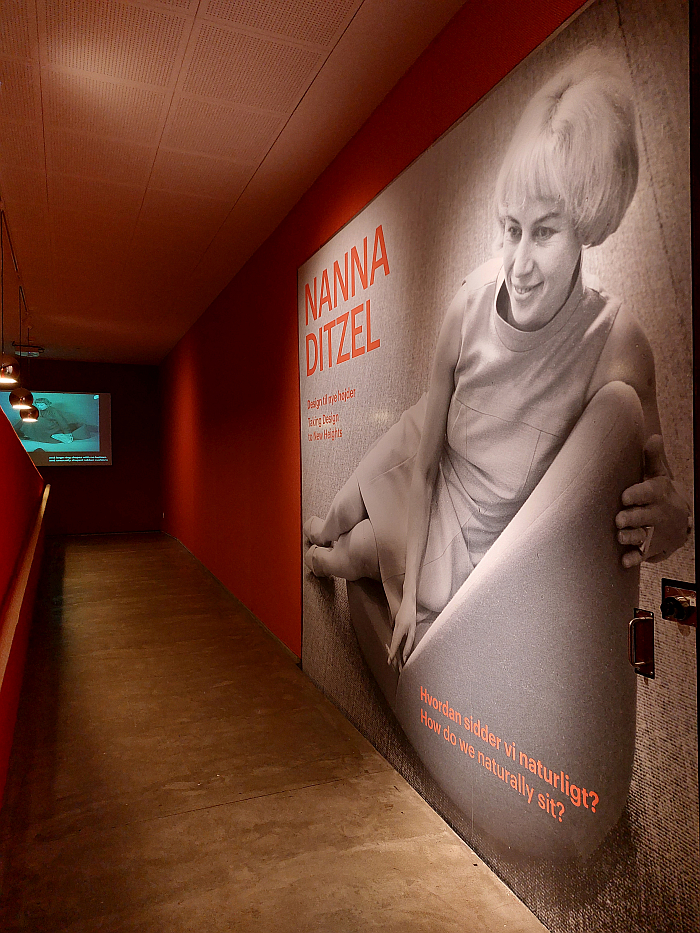
As ever with monographic exhibitions at Trapholt the spatial arrangements of the museum complex mean that Taking Design to New Heights offers numerous, equally valid, possible starting points, and while conventional wisdom would, invariably, counsel you to begin with the essentially chronological journey through Nanna Ditzel's career, much as we started this post with a very brief biographical journey, we'd suggest you save that for later and start in the large exhibition hall with its recreations of five so-called Stairscape installations, a Stairscape concept developed in the early 1950s by Nanna and Jørgen after, according to Nanna, the pair stood atop their dining table and viewed their living room from above, a simple change of perspective, that fundamentally altered Nanna and Jørgen's perspectives on interiors, furnishings and furniture. And which led the Ditzels to begin developing ideas of spaces that grew vertically, saw them begin approaching rooms as transient 3D entities not as static 2D canvases; a position which received its first public expression in May 1952 with their installation for the exhibition Wood, Form and Colour in the premises of the auctioneers Winkel & Magnussen in downtown Copenhagen. A 1952 Stairscape installation popularly known as Gummicellen, The Padded Cell, and which although, as can be appreciated in Taking Design to New Heights, is very strong in the Form and Colour, largely ignores the Wood of the exhibition title/concept, thus ignores that wood that, certainly in 1952, was the defining feature of furniture produced in Denmark; the focal point of the Ditzels' Gummicellen being very much the upholstered objects which could be chairs, could be chaise longues, could be pouffes, could be cushions. And are and were if used as such, otherwise they remain abstract geometric forms that invite interaction and exploration.
An invitation to interaction and exploration warmly extended by Trapholt: very pleasingly and very satisfyingly, and very importantly, visitors are encouraged, empowered, to enter, to access, to use, to sit on, lie on, lounge in, move over, experience the five Stairscapes as Nanna Ditzel (and Jørgen before his untimely death) intended you to. And which is not only exactly how exhibitions about furniture and furniture design and interior design should be experienced, tactilely, actively with your own body, not disassociated from a distance, not through the eyes alone, but also, inarguably, is the best possible method to begin to approach the positions, intentions, motivations of not just the Stairscapes, but of Nanna Ditzel. To begin to approach questions of the relevance and legacy of Nanna Ditzel. To begin to approach an appreciation of that "different" a Nanna Ditzel understood was there, waiting to be expressed. And is also a lot more fun and rewarding than looking at and thinking about furniture objects on pedestals.
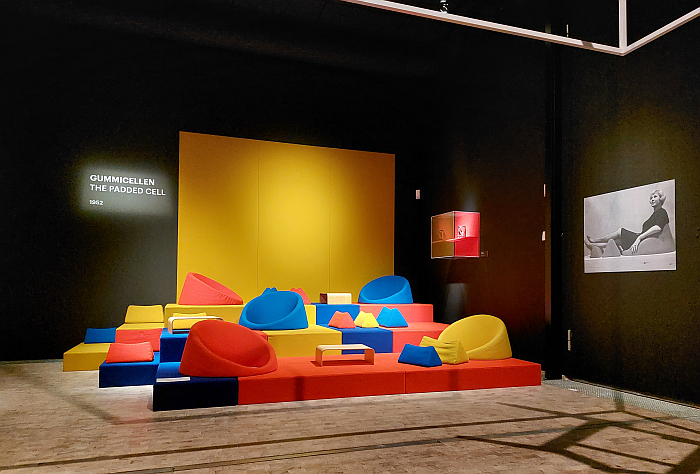
And an interactivity that pleasingly continues outwith the large exhibition hall, although take care, not all the exhibited objects are to be tried; but a great many are, including the so-called Solgården from 1962, a work that resembles a ball pool without balls, or a swimming pool without water, a work which as the creation of an upholstered space within in a space is very reminiscent of, for example, Luigi Colani's 1970/71 Pool seating landscape for Rosenthal or Superstudio's 1968 sofa Bazaar, albeit for outdoor use: less a room within a room as a garden within a garden. A space within a garden within which to relax secluded from all around you, or as a collective space for socialising, playing, picnicking: why sit rigidly with friends and family at a table when you can freely lounge together?
In addition you can, should, must, delight in the joyful weightless of Nanna and Jørgen's 1959 wicker Hanging Egg, an object which offers an alternative take on cocooning yourself in a Danish Æg, Egg, to that proposed, more or less simultaneously, by Arne Jacobsen, Æg obviously being very popular in late 1950s Denmark; a hanging wicker Æg originally produced by R. Wengler a Copenhagen based wicker furniture manufacturer through whose door a stellar roster of Danish architects and furniture designers passed either side of the second World War, thereby helping remind us all of the singular, and all to regularly ignored, place wicker takes in the (hi)story of furniture design in Europe; an R. Wengler with whom the Ditzels realised numerous products in the 1950s, wicker furniture realised alongside Stairscapes and other more conceptual projects that underscore the scope of the pair. And a wicker Hanging Egg which although from 1959 is a strikingly appropriate response to contemporary ways of working and living, to "the way people live" today, with our ubiquitous mobile digital devices. Is an Æg that has unquestioningly retained its freshness over the decades.🙌
While away from Nanna Ditzel's furniture and interiors per se there is a very nice, very primary school art class esque, invitation to play with light and shade, and thus to explore an important element of Nanna Ditzel's work, and that via the simplicity of placing a selection of objects, primarily metal and glass kitchen objects, on top of an overhead projector; an installation which aside from allowing access to thoughts on light and shade, and aside also from the associations brought forth with a László Moholy-Nagy, an individual who we really didn't expect to meet in an Nanna Ditzel exhibition, but who isn't that out of place in Taking Design to New Heights, also posses the question of where the overhead projectors came from? We'd long assumed that in our high-tech age the overhead projector was extinct, only to be found in the dustiest corners of dustier archives. But were delighted to see they are still a thing.
And having tried Nanna Ditzel's designs, having familiarised yourself, your body and your senses with her works, you can then move onto the aforementioned (more or less) chronological journey through the career and work of Nanna Ditzel. While always maintaining the option to return to a Stairscape or a Hanging Æg to reflect on that met in the course of that journey.
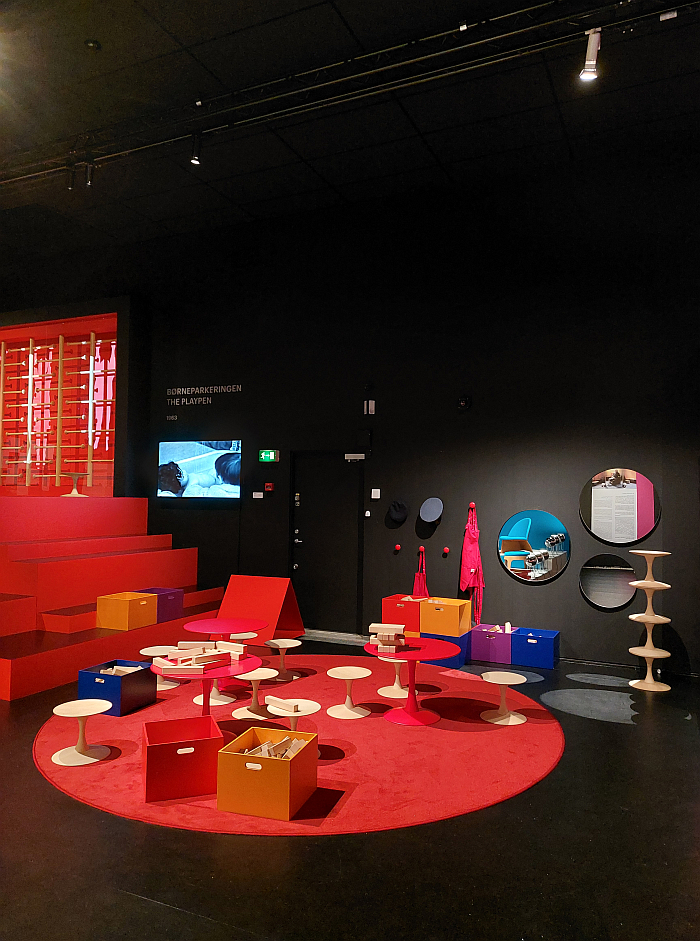
A journey that opens in the 1940s with projects realised together with Jørgen including, as the most prominent exhibit, and, according to the curators, one of the pivotal, central, objects in the development of Nanna Ditzel (and Jørgen Ditzel), the so-called Hjertesofaen, Heart Sofa, a work which, no, isn't and wasn't the only heart shaped upholstered furniture object realised in post-War Denmark, but was realised a decade before that of which you're thinking, and which brings us, finally, to that elephant that lingerthe rooms of Taking Design to New Heights, and to whom we shall, must, return; a 1949 Heart Sofa which in its sweeps and curves must be considered very much in context of the flowing organics of a Finn Juhl, a parallel to a flowing, sculptural Finn Juhl that, as one can read in Taking Design to New Heights, isn't a coincidence, Nanna and Jørgen had become friendly with Juhl in the later 1940s and he was a very important influence on their development at that period; albeit, we'd argue, Nanna & Jørgen rejecting in their works the very often extreme curves of a Juhl. Joyous as Juhl's more extreme curves are. And a Heart Sofa that must also be considered in context of the 1920s and 30s works of an Arne Jacobsen, and as presented in context of Arne Jacobsen – Designing Denmark at Trapholt, albeit, again, much more reserved and understated in its geometry and silhouette than Jacobsen's, at times, vivacious take on Art Deco. And pre-War works by Jacobsen which remind that the much hyped organic of post-War design in Denmark wasn't a novel post-War phenomenon. And certainly wasn't something novel imported from America. If anything the influence was from Denmark to America. Thanks in no small measure to a Finn Juhl.
And a heart shaped sofa that stands in Taking Design to New Heights in front of a selection of seating objects by Nanna Ditzel (and Jørgen Ditzel) from across the 1950s and 60s, a collection of seating furniture which, among other functions, helps elucidate both the wide variety of materials Nanna Ditzel worked in and with, and the equally wide variety of seating solutions Nanna Ditzel developed, confirms that scope that the simultaneous development of wicker chairs and Stairscapes implies; allows one to appreciate that Nanna Ditzel very much could do, a did do, for want of a better term, conventional seating, and did conventional very well; while the less conventional approaches underscoring that a Nanna Ditzel appreciated that while the conventional served their purpose there were alternatives. That one could do things "different".
Should do things "different".
"Having four chairs around a table is by no means the only option available", Ditzel tells us from an undated quote in Taking Design to New Heights, "Personally, I would much rather lie down to talk".2 A preference that can be well understood in the regularity with which the option to lie down is offered in Nanna Ditzel's canon, including in the so-called Floating Dock from 1961, essentially a modular sofa landscape from an age before modular sofa landscapes. And a preference for lying down as the best form of sitting that places Nanna Ditzel very much in context of the (hi)story of domestic arrangements; across time, and geography, societies and individuals have lain, reclined, in both social and business contexts, an international (hi)story of reclining as the preferred form of sitting, inarguably, most popularly known in a European context by the Klinē of Ancient Greece.3 And what are an Anton Lorenz's post-War phat reclining armchairs if not an invitation to lie down in your living room by way of sitting. If lacking the reduction and formal grace of a Ditzel, or a Klinē. And today when a sofa is being chosen thoughts of reclining on it, invariably, have primacy over thoughts of sitting on it. Thoughts on social and formal lying down through (hi)story, thoughts on the past as the basis of the future which very much reminds of a P.V. Klint's 1901 admonishment that we should "never indulge in copying old styles, but through a thorough education and a study of old ages’ unfailing taste and dignified approach to style, cultivate our personal style, with the idea of creating cosy, beautiful, and grandiose surroundings for the life and activities of contemporary man"4, whereby, as an Nanna Ditzel elegantly and assertively, but always respectfully, reminds us all, the focus must always be on the "contemporary": "contemporary" society, "contemporary" activities, "contemporary" "way[s] people live". A contemporary that is "different" from previous contemporaries and therefore needs, demands, "different" responses.
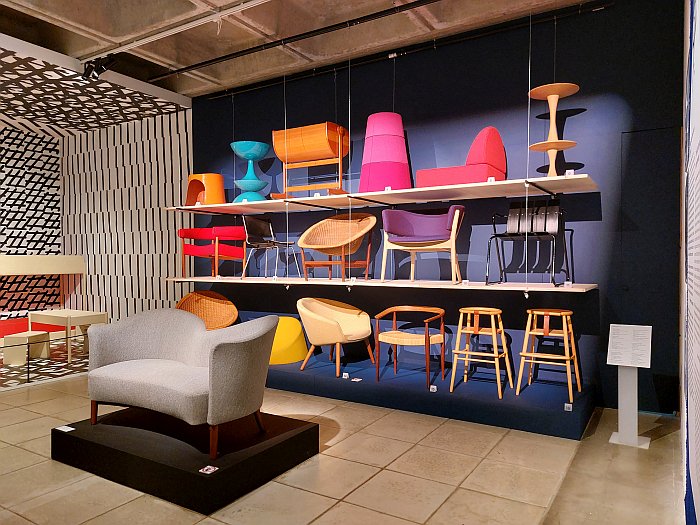
A thematic journey through Nanna Ditzel's career and oeuvre that, amongst other stops, explores Nanna and Jørgen's immersive, stackable, interactive, children's bedroom landscape from 1952, a project realised, as with so many at that period, in cooperation with Gunnar Aagaard Andersen, a creative whose regular presence in Taking Design to New Heights admonishes us to finally finish our text on him; to Nanna Ditzel's 1987 interior design concept for Danish Railway's, then, new IC3 trains, a project in which the fabric Hallingdal played a key role, a Hallingdal to which we shall return; and also very pleasingly includes an extended discussion on Interspace, the showroom and consultancy established in 1968 by Nanna Ditzel and Kurt Heide in London. A period in London to which shall return another day, for it is not only very interesting in the biography of Nanna Ditzel but also informative on the (hi)story of design in Europe; and will restrict ourselves here to noting that alongside being a platform for distributing furniture, textile and jewellery designs by Nanna Ditzel, and an interior design agency, Interspace also saw Ditzel and Heide act as London agents for C&B Italia. A C&B Italia, now a B&B Italia, who for all that they today are most popularly associated with the nobler, excluisver, edges of the contemporary furniture industry, arose in the out-of-control environment of late 1960s Lombardian furniture, and initially made a name for themselves with works such as, for example, Gaetano Pesce's UP collection of expanded polyurethane objects that can be furniture, but needn't be, or the Camaleonda modular cushion system by Mario Bellini, and thus were very much a component of the "different" being demanded for domestic spaces by Italian designers and architects of the late 1960s, were very much a component of The New Domestic Landscape MoMA New York sought to mediate in their 1972 review of contemporary Italian furniture and interior design. That post-War period of Italian Radicals, that was also a period of Austria Radicals and American Radicals. ¿And Scandinavian Radicals?
In 1976 Nanna Ditzel opined that "Scandinavian design is exciting, although its inspiration comes primarily from Italian furniture design"5, and while that may or may not have been the case in 1976, whereby the naming of Ditzel and Heide's production company as Domus Danica certainly argues towards a strong commercial popularity of Italian design at that period, of Italy as being easily and readily marketable,6 that's a discussion for another day; however, if we skip back a decade from 1976, or two decades, two and half, Taking Design to New Heights allows one to appreciate that conceptually Nanna Ditzel was often ahead of the Italians, was advancing positions, was developing solutions and suggesting a "different" that Italians still had to learn to formulate the questions that would lead them to. We're not saying that Nanna Ditzel was the single source of inspiration for 1950s and 60s Italian furniture, that would be a ridiculous, and unsustainable, proposition. Are saying that Nanna Ditzel, and the elephant that is still within the rooms around us, was/were often ahead of the Italians. And thus Taking Design to New Heights allows one to approach an understanding that much as their was without question a two way dialogue between Denmark and America in the post-War years, there was also a two way Danish-Italian dialogue. And where does that leave the breathlessly vaunted and much celebrated 'Danish Design'?
Yet whereas in Italy, and elsewhere, those who in the course of the 1960s embraced the "different", those who sought to free us from the burden of carrying the "old and defunct", are looked back on from today as being Radical, that isn't the case with Scandinavia. In many regards 'Scandinavian Radical' doesn't scan as a word group. There's an incongruity. Which arguably has a lot, everything, to to do with how furniture design from, and the (hi)story of furniture design, in Scandinavia is presented and discussed today. There's no space for Radicals in a Jørgen Roos' "time-honoured tradition and quality craftsmanship".7 But viewing Taking Design to New Heights one tends to an appreciation that Nanna Ditzel was, and still is, very radical, and needs to be understood as Radical. Needs to be understood in context of the international experimentation towards a radical "different" as Europe, European society, moved ever further away from the second World War. Just as she needs to be understood as the creator of tactile, responsive, user-orientated, functional objects, objects which very often rejected the conventional understandings of functionalism that had arisen inter-War and had been continued in the immediate post-War decades; needs to be understood as a creative who advanced, demanded, a "different" appreciation of functionalism, a "different" definition of function in context of furniture and interiors.
Thoughts on Scandinavian Radicals, and appreciations and definitions of function and functionalism, which brings us, finally, to that aforementioned Verner Panton shaped elephant that inhabits the rooms of Taking Design to New Heights.
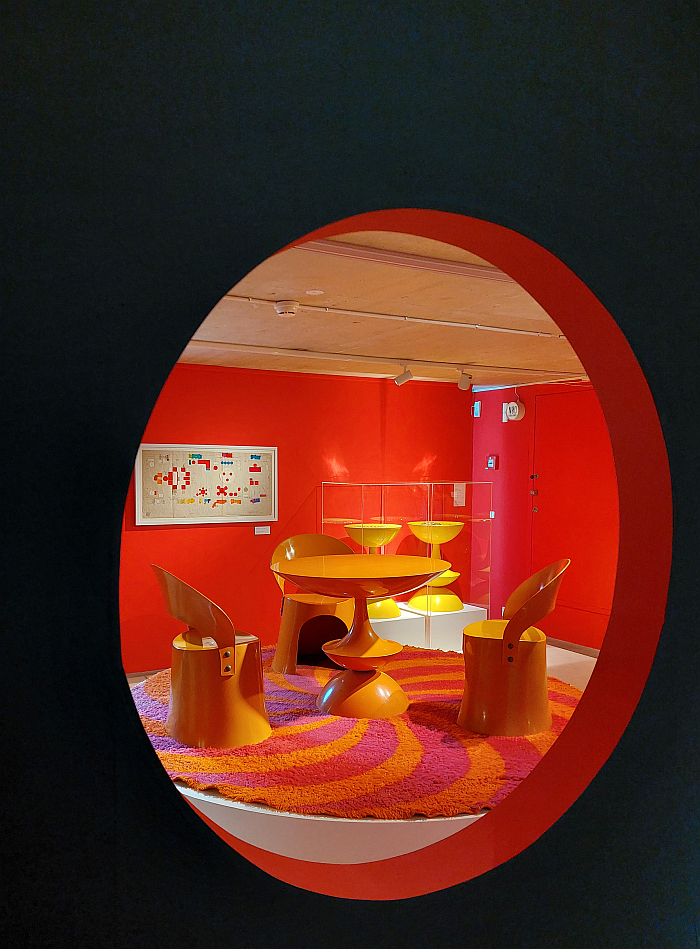
The parallels between Verner Panton and Nanna Ditzel are ever present in Taking Design to New Heights, simply cannot be ignored; not just in the colours, the upholstery, the materials, the forms, the definition of function, but also in the move in later years to more materially restrained yet almost borderline Surrealist pieces. Yet for all they were both born in mid-1920s Denmark, both attended the Kunstakademi in the 1940s, both took their first professional steps in post-War Europe, both spent long periods outwith Denmark immersed in international waters — Nanna Ditzel in London, Verner Panton initially throughout Europe in his VW bus, subsequently in Basel — and both were without question Scandinavian Radicals, even if the term refuses to accept its own existence, the question as to why the parallels isn't that straightforward, and that not least because they are parallels, not similarities; for all that there very much exists a dialogue between the works of Verner Panton and Nanna Ditzel, and between the positions and approaches of Verner Panton and Nanna Ditzel, they're not the same, and we'd argue, it's relatively straightforward to tell a Verner Panton work from a Nanna Ditzel work. But why the very clear parallels and not similarities?
That's a question that can wait for another day, it is however important to note here that Nanna Ditzel was often a tick ahead of Verner Panton. Not always, and there was often very little in it, them both making similar movements more or less simultaneously, apart from with the aforementioned heart shaped upholstered furniture concept where Ditzel was a good decade ahead of Panton; but then Ditzel did have the influence of the sculptor Finn Juhl whereas in the late 1940s/early 1950s Verner Panton was very much associated with the industrialists Arne Jacobsen and Poul Henningsen. And obviously the date of publication of an object tells us nothing about when the idea first arose, how long the development was, which other projects interrupted that development, how many dead ends they wandered down on the path to publication. And also both did things the other didn't, there are divergences as well as parallels; but where there are parallels, Nanna Ditzel appears to have often been a tick ahead of Verner Panton, a bit quicker to formulate and express positions than Verner Panton.
Yet which of the two Scandinavian Radicals is most visible today?
Which is a crime.
Not that we're apportioning any blame to Verner Panton, far from it, we believe he was a decent, honourable chap; but are apportioning a lot of blame to the established narrative of design (hi)story and for all to the unquestioning manner in which that (hi)story is consumed by us all, collectively and individually. And are also apportioning blame to ourselves: did we mention Nanna Ditzel in context of Verner Panton – Colouring a New World at Trapholt? No, we didn't. We could have, should have, but we didn't see that path to Ditzel in our focus on Panton, but focussing on Ditzel we see Panton. Which is wrong. One seeks to explain Ditzel in context of Panton, but wouldn't consider explaining Panton in context of Ditzel, one identifies a Panton shaped elephant in a Ditzel exhibition, but not a Ditzel shaped elephant in a Panton exhibition. Which is awful. And very informative.
Taking Design to New Heights is an urgent demand to us all to reflect more critically on the established narrative of the (hi)story of furniture design. To appreciate that there is a "different" narrative out there. Different as in 'more probable', 'more accurate', 'more nuanced' and not a fictional, invented Trumpian 'different'.
Similarly, Nanna Ditzel allows access to reflections on the wider place of females in the (hi)story of design in Denmark. As noted from The Magic of Form – Design and Art at Kunsten Museum of Modern Art, Aalborg, in the popular narrative of design in Denmark Nanna Ditzel appears all of a sudden as the first ever female furniture designer in Denmark, and remains the only female furniture designer in Denmark over a great many generations. All other furniture in and from Denmark throughout (hi)story having been designed by men. But was that so? If it was, why? If it wasn't, why is it so told? And, and a question you don't want to ask but must, had Jørgen not died so tragically young, how would (hi)story remember Nanna Ditzel? Just as the colours and textiles and jewellery, or also as the furniture? As a muse or as a designer? Here isn't the time nor place for that discussion on the (his)tory of design in Denmark, but Taking Design to New Heights, and for all Nanna Ditzel's unfair, unjustifiable place in the shadow of a Verner Panton in popular appreciations, a Verner Panton Nanna Ditzel is and was more than equal to, and contributed every bit as much as, very much reminds that it is a discussion that urgently needs to be initiated.8
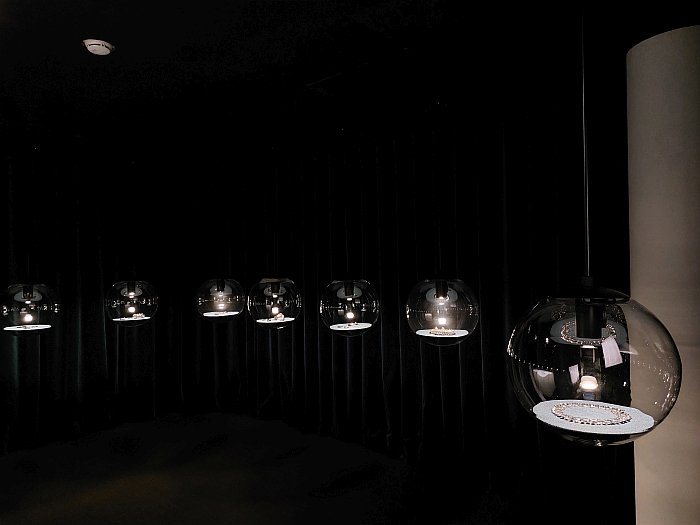
A very pleasing and very satisfyingly designed exhibition, not just on account of the invitation to actually physically engage with the Stairscapes and other Nanna (and Jørgen) Ditzel works, which is genuinely wonderful, a joyous decision, but also through the scenography which is as much a stroll through a landscape as it is through an exhibition, Taking Design to New Heights also goes beyond Nanna Ditzel's furniture and interiors per se to reflect on her associations with nature, her observation of and inspiration from nature in the development of her works, and as exemplified by, for example, the 1990 Butterfly Chair, the 1996 Sea Shell chair or the pterodactyl-esque folding stool from 1992, not that we believe there actually were pterodactyls in Denmark in the 1990s, but there may have been; introduces her jewellery design, a facet of her work that, as one learns, shouldn't be considered an additional element of her oeuvre but very much as a central competent that informed and influenced her wider work.
And also introduces the aforementioned Hallingdal textile, a textile that is and was without question one of the more important innovations of the 20th century textile industry, and remains a go-to-textile for designers and manufacturers of all hues; and a Hallingdal textile developed by Nanna Ditzel in 1964/65 for Percy von Halling-Koch, a, by all accounts, outrageously flamboyant businessman who in addition to owning the furniture manufacturer Plus-Linje, who released some of Verner Panton's earliest furniture designs, including his Heart Chair, also owned the textile company Unika Vaev, Unique Material/Fabric/Weave, which sums up Hallingdal quite well.
Developed conceptually in context of Ditzel's considerations at that time on upholstery fabrics as active components of a space, as more than just a passive outer coating, and developed physically in context of a truly absurd sounding journey through Europe in an open top MG, including visiting Norway in winter, which is ridiculous, but 'twas in Norway where a manufacturer was found for that most 'Danish' of textiles, one of the fundamentals of Hallingdal is Ditzel's consideration on colour and material that it embodies; on the one hand the mix of wool and viscose and on the other the variations, and for all the fluctuating, transient, breathing, sentient variations of colour, Ditzel achieved. And which thus allows for a comparison of Ditzel's development of Hallingdal with the contemporaneous positions and approaches of a Bernat Klein, a textile designer who was also very much aware of the need for something "different" in post-War textiles and sought it, found it, in mixes of materials and in intense, intensive considerations on colour and colour combinations. And a textile designer who, as we all remember from Bernat Klein. Design in Colour at the National Museum of Scotland, Edinburgh, cooperated with Danish textile manufacturers in the 1960s and 70s and in doing so helped, as a Serbian born, Scottish citizen, to inform Danish interiors of that period. Which brings us back to the question of the foundations on which 'Danish Design' stands.
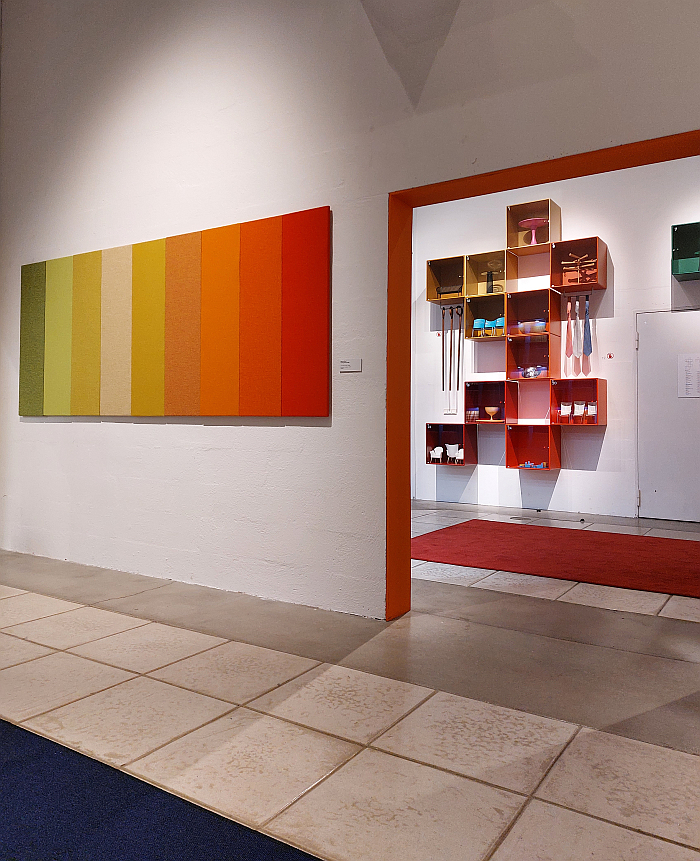
In which context, Taking Design to New Heights also draws one's attention the fact Nanna Ditzel worked industrially; Nanna Ditzel's work isn't that "time-honoured tradition and quality craftsmanship" the Danish furniture industry has been keen to promote since the 1950s. Not that it isn't and wasn't without its craft sensibilities, isn't and wasn't in anyway dismissive of craft, something that can be seen, and enjoyed, in, for example, the various wicker and bamboo objects, in the Toadstool children's furniture, in a delightful multi-level side table with integrated fruit bowl from 1980 realised by Brdr Krüger, one of those stalwarts of the Copenhagen carpentry scene, and a work which you can see forming on the lathe as you view it, or the aforementioned Trinidad chair, a work which while featuring a machine milled seat and backrest, can, must, be understood as a craft approach. In an industrial context. Whereby particularly interesting and informative is that, by all accounts, the first Trinidad chairs were realised with the very first CNC-controlled milling machine in Denmark. A technological innovation that everything you've learned in Taking Design to New Heights tells you it was inevitable Nanna Ditzel would explore meaningful uses for.
And a technological innovation in 1990s Danish carpentry that reminds us all that one of the reasons Danish designers focussed on handcrafted wood in the mid-20th century was because that was all they had; Denmark at that period wasn't an advanced industrial nation, it was a relatively poor country with a lot of wood. Something that began to change in the course of the 1950s, we all remember, for example, the excitement and pride with which Jacobsen's SAS Royal Hotel in Copenhagen, with its inventory of Eggs, Swans, Drops etc, was celebrated by the Danish authorities in context of the 1958 exhibition Formes Scandinaves at the Museum des Arts Décoratifs Paris as something painfully contemporary, represented Denmark as a member of the post-War industrial elite while the rest of Scandinavia were still carving wood. Wood carving Denmark quickly returned to when they realised it was more marketable than industry. Taking Design to New Heights allows one to appreciate that Nanna Ditzel embraced industrial production and industrial materials from the very start of her career, was an important innovator, helping industry in Denmark to grow and develop, always appreciated there were "different" ways to produce and supply furniture. And which is, we'd argue, one of those reasons Ditzel, and Panton, sit so uncomfortably in the (hi)story of design in Denmark; that way although you know Denmark wants to fully embrace them, they know that doing such involves changing the narrative of 'Danish Design', means admitting it's long been a marketing led narrative. As is the equally fabled Scandinavian Design. Taking Design to New Heights is an invitation to make that admission and to embrace the industrial that Ditzel and Panton, and Jacobsen, and Henningsen, and Aagaard Andersen, et al advanced and demanded as a necessary response to the changing "way people live". If all very "different" responses.9
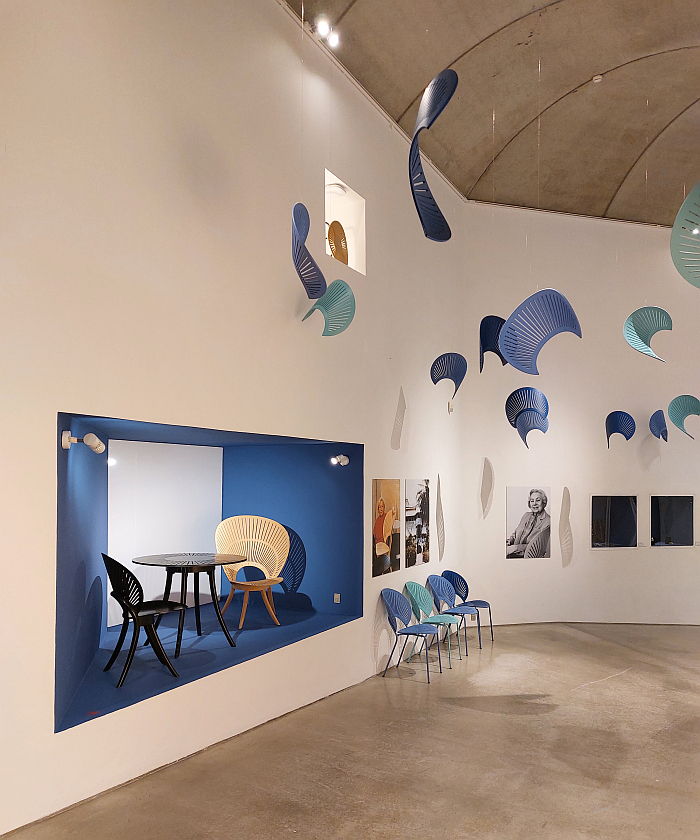
In addition, if remaining very much in context of the Nanna Ditzel and the (hi)story of design in Denmark, Taking Design to New Heights also allows plenty of time and space for reflections on Nanna Ditzel's work in context of the teachings of Kaare Klint, a Kaare Klint who may or not officially have been a teacher of Ditzel, but whose classes she attended and whose positions dominated furniture design in Denmark during her formative years, would have been inescapable in 1940s Copenhagen. A Kaare Klint who for all his stubborn adherence to pre-metric measurements, and to teak, very much embraced his father's opinion of learning from the past, or as Kaare Klint opined in 1930, one should "build on the experiences that have been garnered over the centuries. The problems are not so new, they have in many cases been solved before".10 But importantly, and as with his father, was very much the opinion that one shouldn't copy the past 1:1 but adapt it to the needs of the day, that furniture "must be designed on the basis of practical necessities"11, whereby, we'd argue, one can freely understand the meaning as 'contemporary practical necessities'; "practical necessities" that are also at the foundation of much of Nanna Ditzel's work, Ditzel designing not for some abstract reality, or based on some theoretical position as regards furniture and interiors, but designed on the basis of observation of, reflection on, discourses with "the way people live", and the question of what supports contemporary living and what hinders it, what does contemporary living need, what is "old and defunct".
And while, yes, her 1961 comment that "we don't have any neatly square people to place in that kind of furniture"12 can be seen as criticism of the standardised quadratic of a Kaare Klint, it can also be seen as a position Klint himself would have arrived at in the course of the 1960s. While still measuring in inches, feet and fathoms. And that not least because what Kaare Klint did was "different", a different different in a different age, but very much a response to contemporary changes in "the way people live", was based on observation of, reflection on, discourses with 'contemporary practical necessities', on questions of how furniture objects arose, were produced and fitted into contemporary society. Which is what we also need today; while many of the physical responses of a Kaare Klint or a Nanna Ditzel remain valid and meaningful, see, for example, the aformentioned, Hanging Æg or Gummicellen or Toadstool, amongst many others — society rarely changes that much that quickly, it tends to be a gradual evolution rather than an abrupt revolution — what we need today is less the objects of a Klint or a Ditzel, as their understandings of "different" as a perspective not as an object.
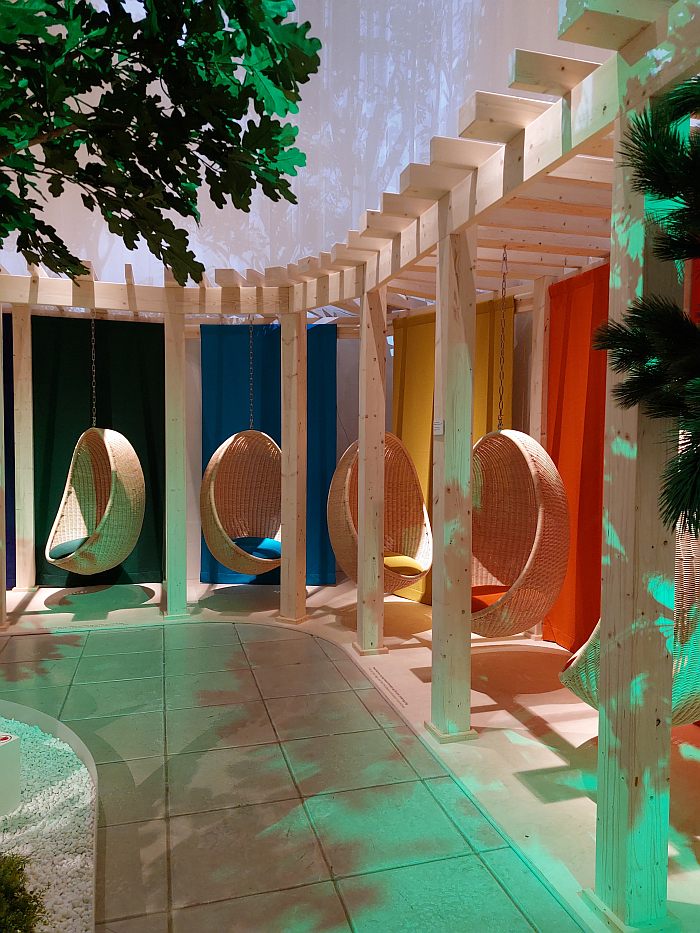
Verner Panton once proposed the creation of "a museum of experiments in living space, where, dreaming into the future, one is reminded of our dreams and hopes"13; Taking Design to New Heights isn't that museum but is very much an exhibition that through allowing one to approach better appreciations of how Nanna Ditzel employed space rather than placing objects in space, better appreciations of Nanna Ditzel's understandings of materials, better appreciations of Nanna Ditzel's understanding of colour as more than just visual, better appreciations of Nanna Ditzel's understandings of function, better appreciations of Nanna Ditzel's movements and developments throughout her long career, better appreciations of Nanna Ditzel as a Scandinavian Radical, questioning and challenging, better appreciations of how Nanna Ditzel didn't dream into the future but actively worked towards it, Taking Design to New Heights not only elegantly helps elucidate how Nanna Ditzel took design to new heights, physically and conceptually, but helps elucidate how better appreciating and understanding a Nanna Ditzel can help take our appreciations of the (hi)story of design to new heights, help take our definitions of design to new heights, can help take our relationships with the spaces we inhabit to new heights, take relationships between ourselves and our furniture, furnishings and objects of daily use to new heights, take our definitions of "different" to new heights.
A "different" that for all that it today is loaded with scepticism, fear, mistrust, is something to be resisted and restrained, and yes we are now both talking about furniture/interiors and have moved into the land of metaphor, is, as a Nanna Ditzel teaches us, a necessity, "I think things grow so very dull if one's ideas about life stagnate"14 she reflects from poster in Taking Design to New Heights: but not just dull, life, society, would cease. Curiosity, interest, questioning, dissatisfaction, idiosyncrasy, have been important motors in the development of human society, in humanity, not necessarily always in context of chasing after the novel, but certainly in context of being open to the "different". Taking Design to New Heights is an admonishment that it is important we don't lose sight of that. That we continue to demand and explore and engage with the "different". And, yes, we are still in the land of metaphor. And still reflecting critically on a Danish furniture industry that seems intent on stagnating into dullness through its obsession with an invented 'Danish Design'. And still talking about contemporary and future furniture/interiors.
And thus, amongst its many other joys, through allowing for reflections on a Nanna Ditzel's dreams and hopes and future Taking Design to New Heights helps focus our attention on "the way people live" today, and the way we'll live in the future, 'ways' that are "different" than the presents and futures of a Nanna Ditzel, as are society's dreams and hopes, and thereby also allows for reflection on the position that if our furniture and interiors are to be meaningful, supportive and responsive we need to continually unburden ourselves of the "old and defunct", enables a Nanna Ditzel to contribute to those discussions and discourses on how to move forward, a Nanna Ditzel who as Taking Design to New Heights allows one to appreciate has a lot to contribute; and for all enables a Nanna Ditzel through her words and work to remind us all that going forward one of the most important tasks is to embrace the "different" and to regularly view things from a "different" perspective.
Taking Design to New Heights is scheduled to run at Trapholt, Æblehaven 23, 6000 Kolding until Sunday August 11th 2024.
Full details, including information on the accompanying fringe programme, and the Ditzel High Tea, can be found at https://trapholt.dk
In addition the video introduction to Nanna Ditzel that is on show in Taking Design to New Heights is very pleasingly available on the Trapholt homepage, and we warmly recommend it. It's 20 minutes so get yourself a coffee a bit of cake, but do please find the time. (Spoken Danish with English subtitles)
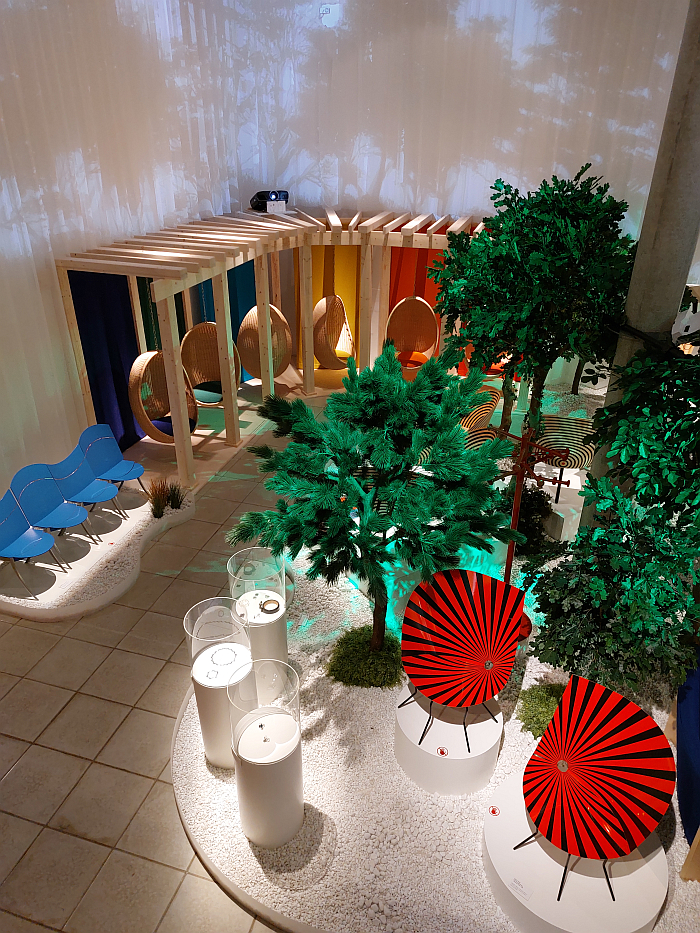
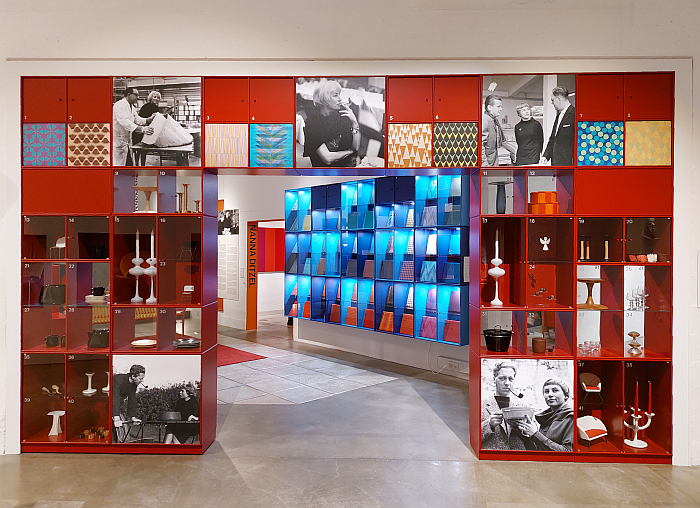
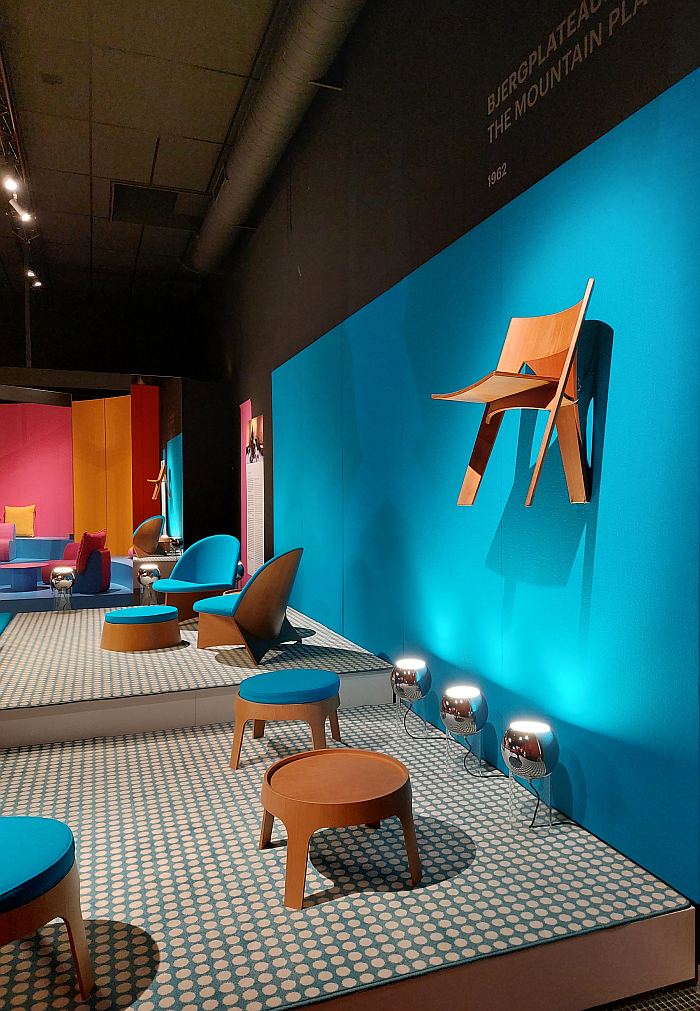
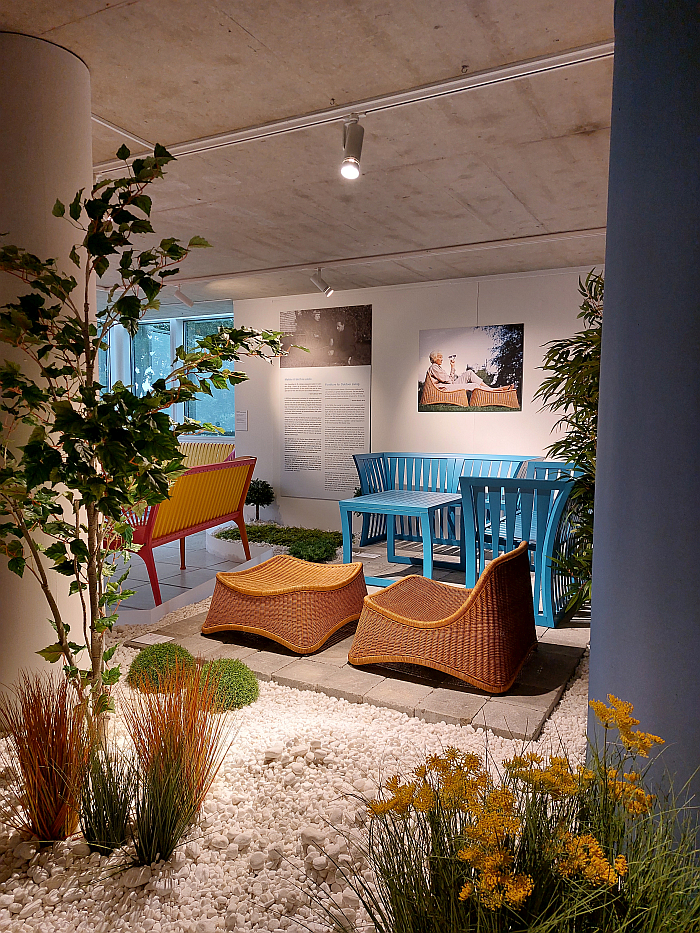
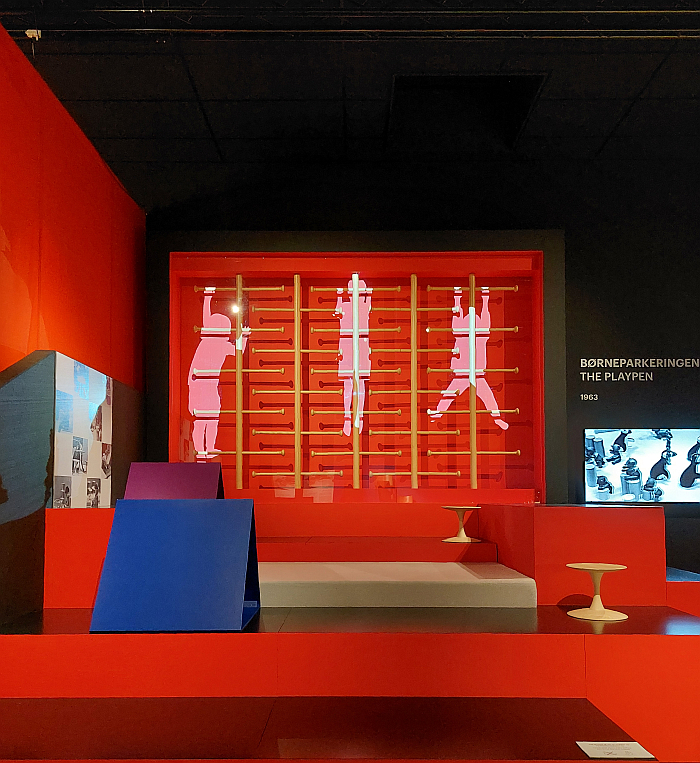
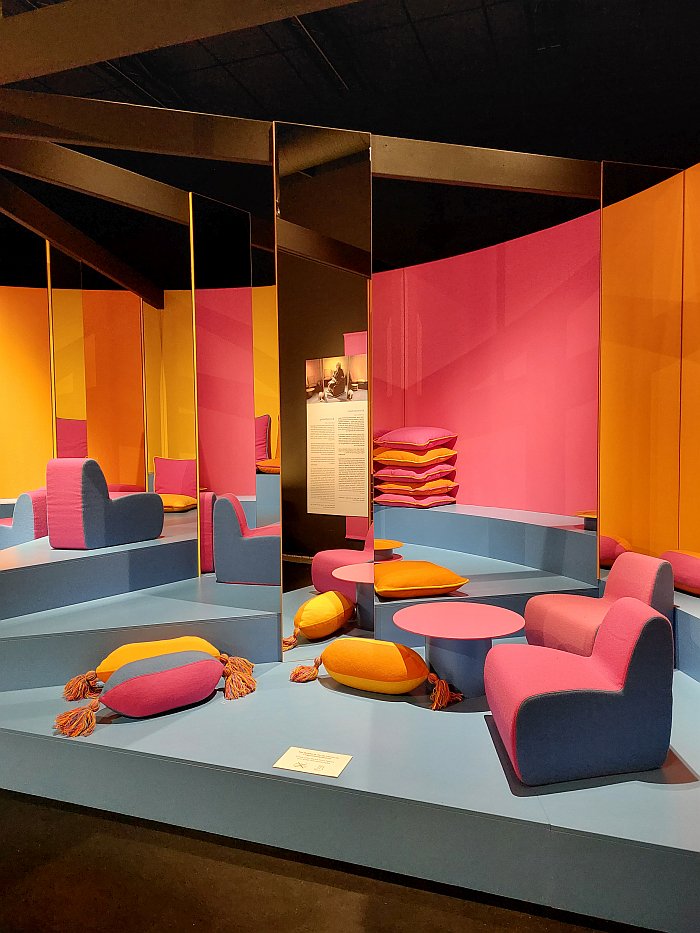
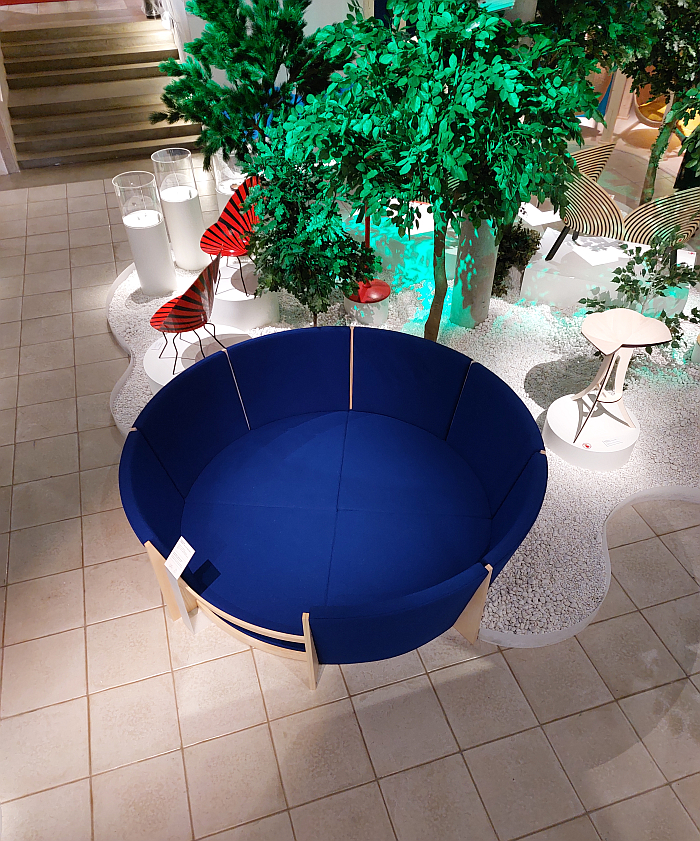
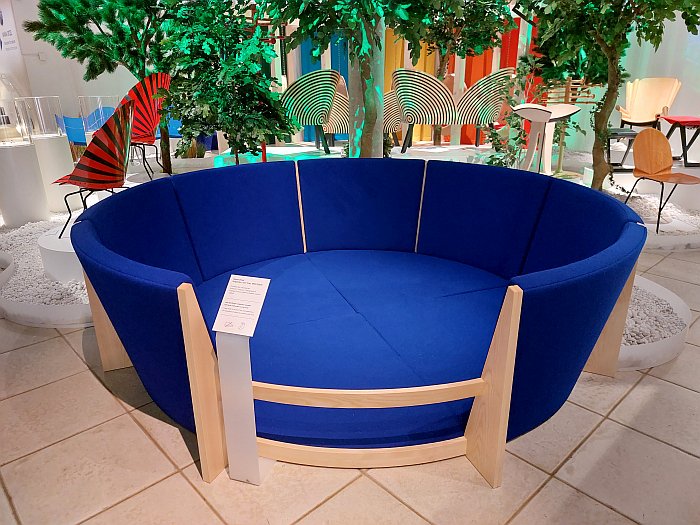
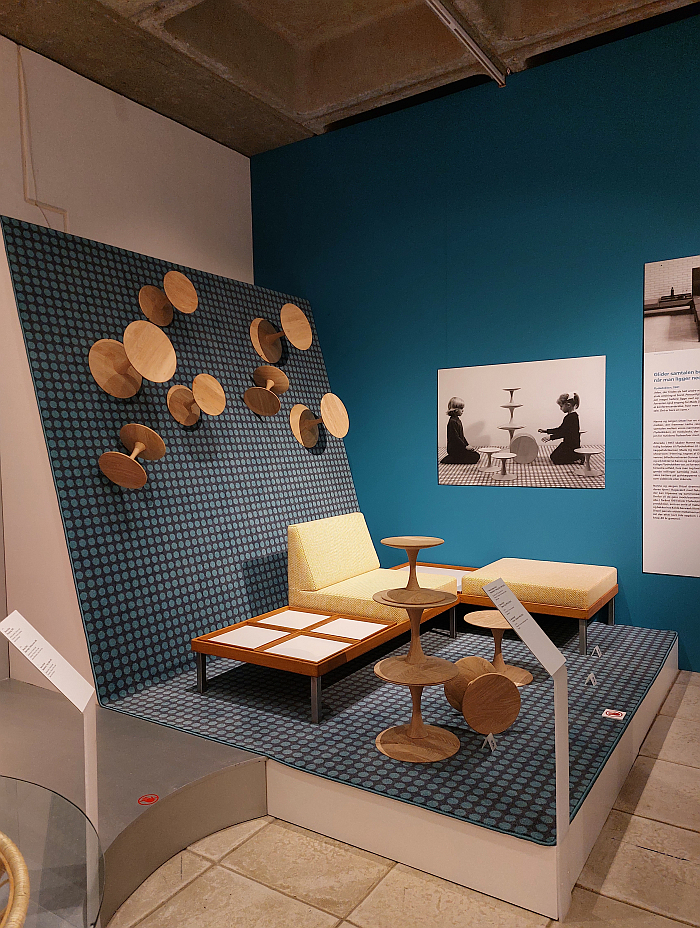
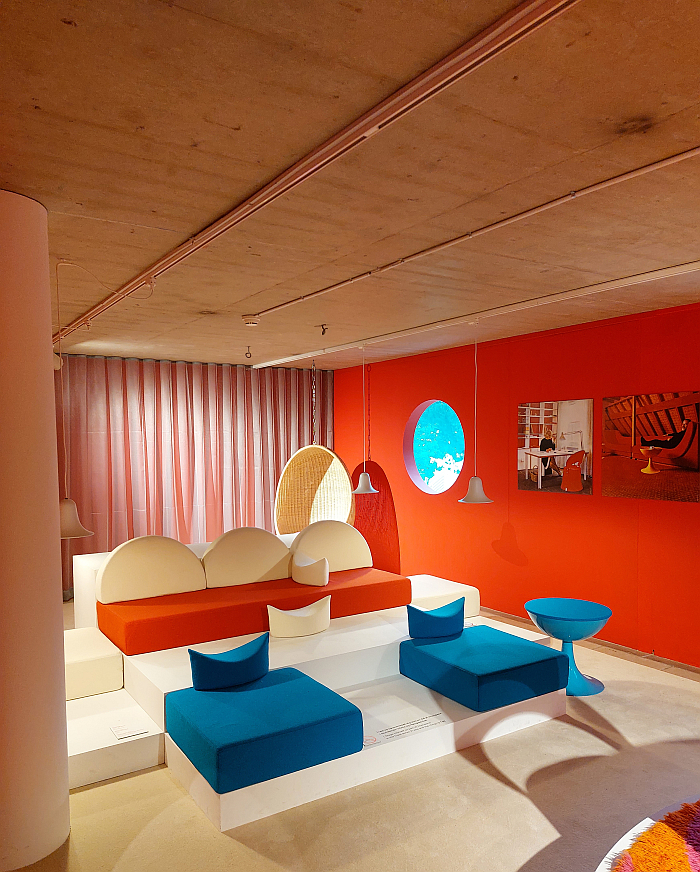
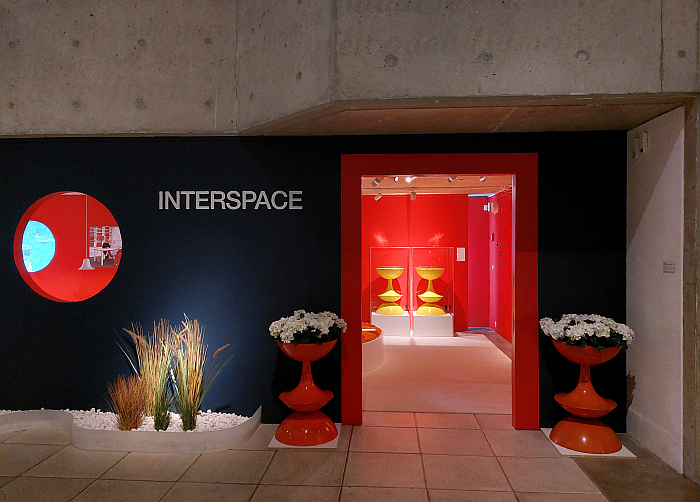
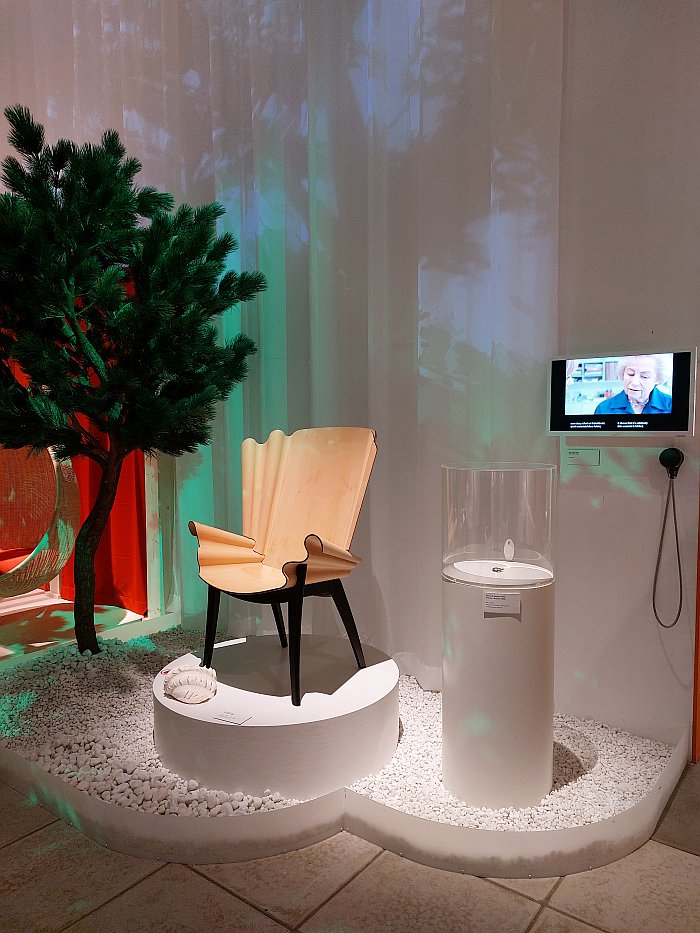
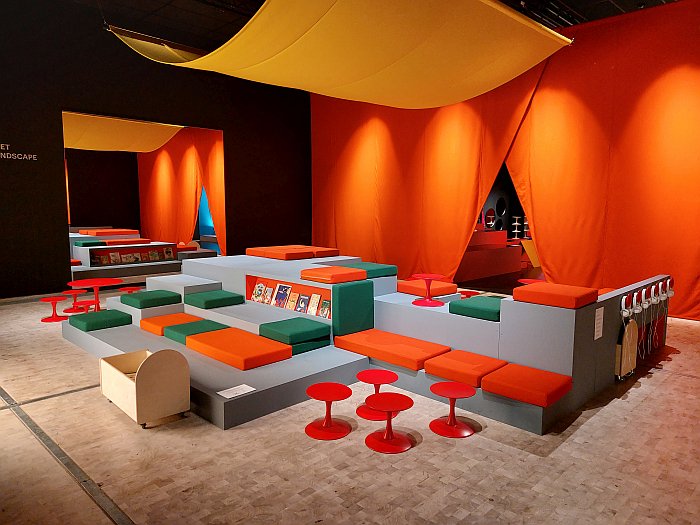
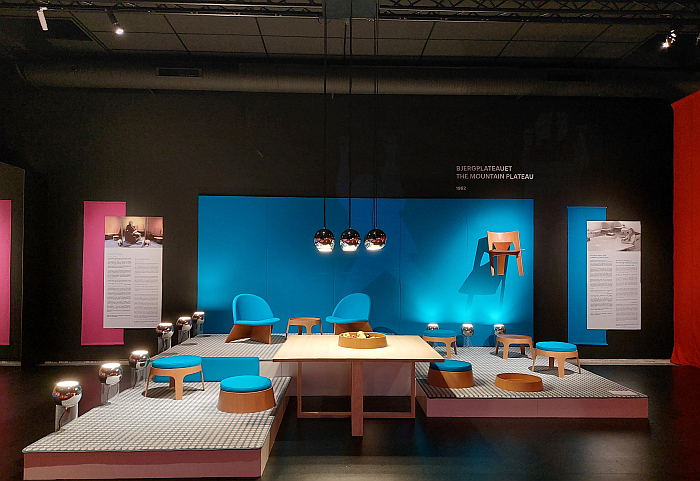
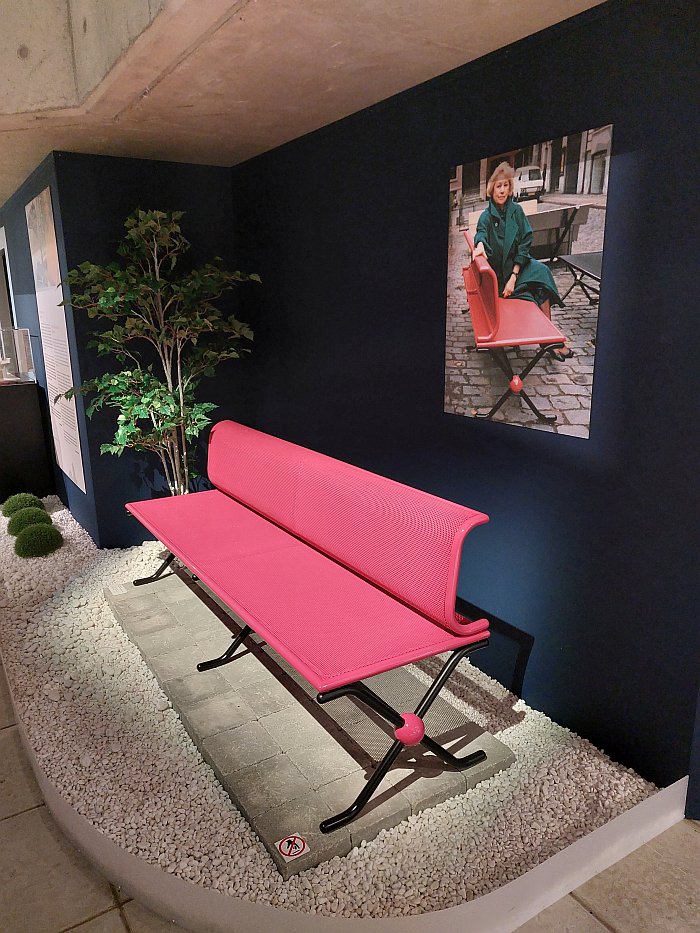
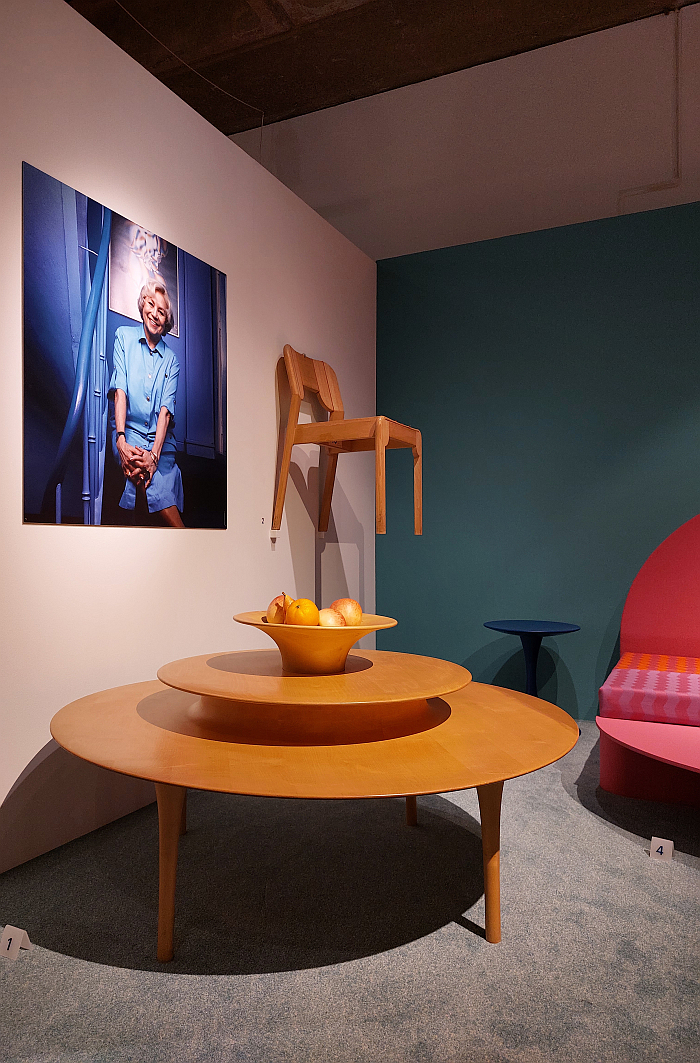
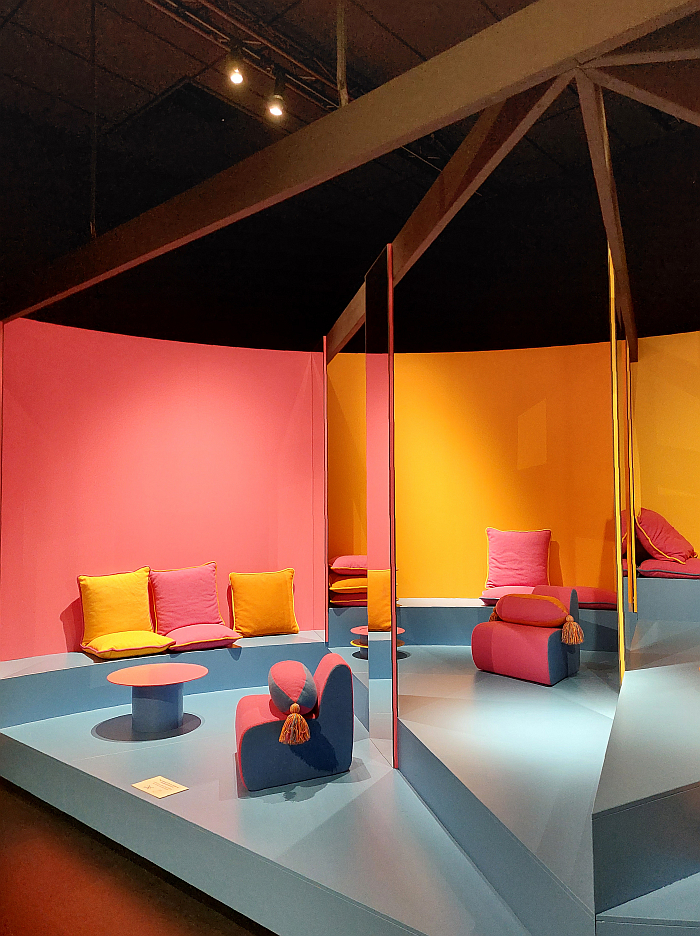
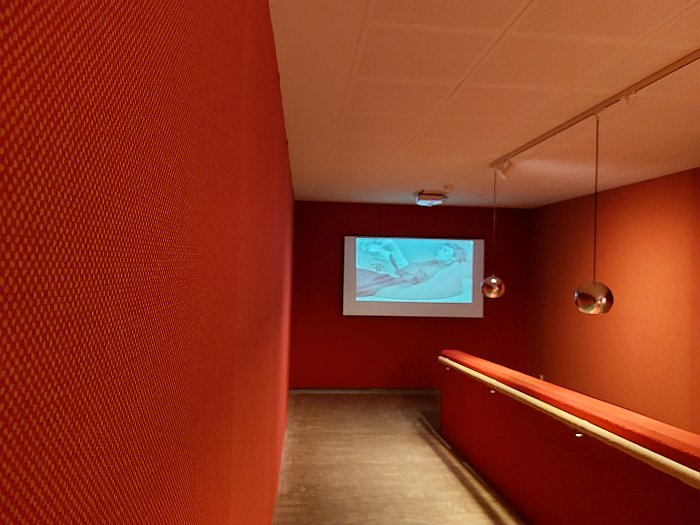
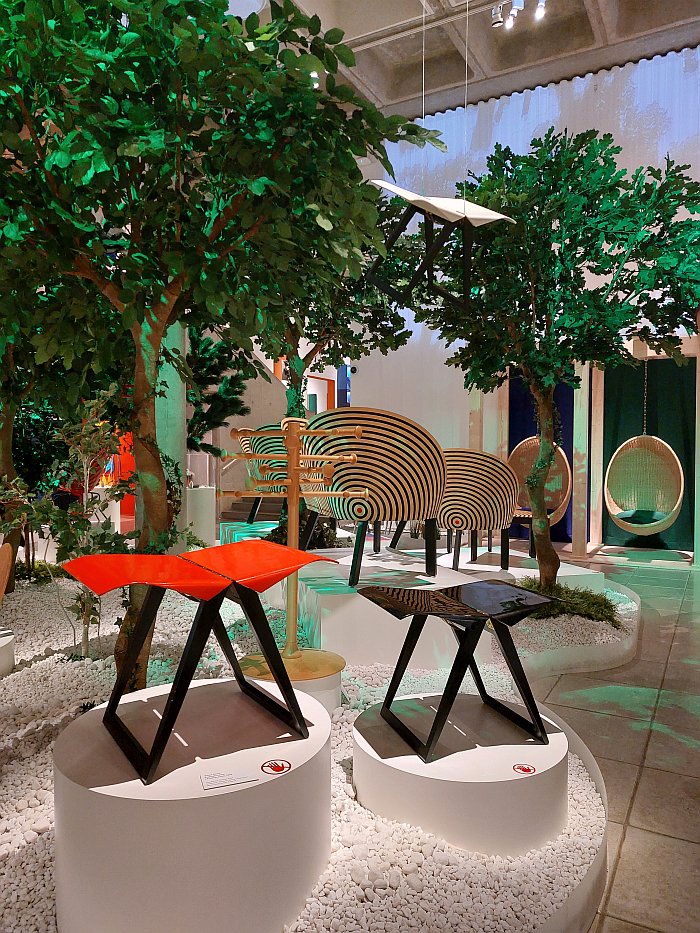
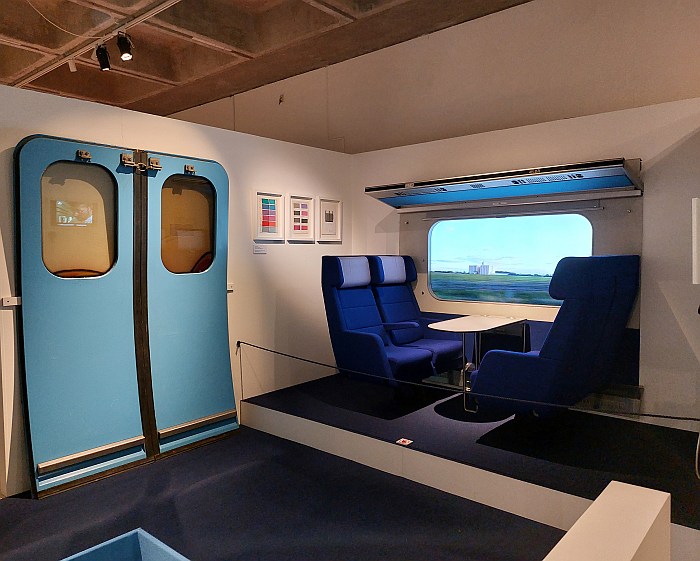
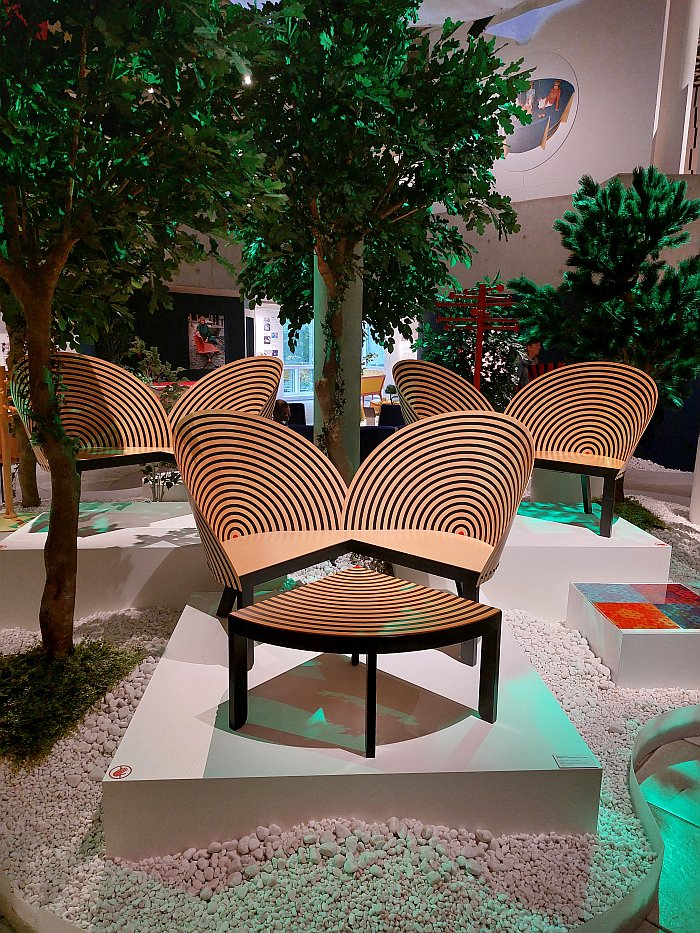
1Nanna Ditzel in the 1961 TV interview Hjemme hos: Nanna Ditzel / At home: Nanna Ditzel, as shown in Taking Design to New Heights. We can't find anywhere it else, but it may be out there somewhere.......
2Unreferenced quote in exhibition. Little winds us up more than unreferenced quotes, it's important to properly reference so that people can find the text and not only read the whole text and thereby, hopefully, deepening their appreciations, but also better understand the context in which the quote was made and thus approach the quote from a "different" perspective. The Taking Design to New Heights exhibition catalogue is however due to be published in late 2023, that may contain references. If it does we'll update
3We are absolutely convinced that a couple of years ago we stumbled across a reference to an ancient Viking reclining sofa, an ancient Viking Klinē if one so will, but now that we need it we can't find it. Which is typical. We will continue searching and update if we find it, because a Viking Klinē is clearly the example we need at this point.......
4P.V. Klint in a speech at the founding of the Society of Decorative Art, 1901, quoted in Arne Karlsen, Danish furniture design in the 20th century [English translation by Martha Gaber Abrahamsen], Ejlers, Copenhagen 2007, page 14
5Unreferenced quote in exhibition. See FN2
6Danica isn't proper Italian, is a bit cod-Italian, sounds Italian. It's actually a Slavic forename. Danese would be Italian, but the design manufacturer Danese had existed since the late 1950s and so, one presumes, the name couldn't be used. And so an alternative was found. Whereby the question why Danese is Danese is perhaps also relevant.... yes it was established by Bruno Danese, but also by Franco Meneguzzo and Jacqueline Vodoz. Why Danese in late 1950s Italy? Because of the associations with Denmark? We no know, but we'll throw it out there........ And the reflections awoken on Bruno Munari, Enzo Mari and Nanna Ditzel.......
7see Jørgen Roos, Danish Design, 1961, English, 16 minutes. Available via https://www.danmarkpaafilm.dk/film/danish-design (accessed 12.10.2023)
8We're unaware of any information as to why Nanna Ditzel started studying carpentry and furniture design, there doesn't appear to be family impetus, as far as we're aware her father was a regular office based business man, and Taking Design to New Heights also doesn't approach the subject, unless we missed it, whereby there may be more in the forthcoming catalogue. But it is an important question, also in context of the (his)tory of design in Denmark, not least because there doesn't appear to be any evidence that anyone questioned Nanna Ditzel as a female furniture designer in 1950s Denmark, as far as we're aware it wasn't an issue, which again poses a loud why? Was it normal but the names of all others females have been lost, or was 1950s Denmark simply so gender neutral that no one posed the question? Whereby we'd also bring in For din skyld Poul Henningsen's Danish entry for the 1965 Eurovision Song Contest and its implication that Danish society was very much a male dominated society. The information is out there, invariably in Danish which means its up to Danes to find it and interpret it.
9Yes, Verner Panton – Colouring a New World was also a moment for that, but looking back such wasn't to the fore, the presentation didn't guide you so much in that direction, the production of his objects wasn't really a theme. Which is an important point: any exhibition is always a reflection of how the curators approached it, the questions they posed, the aspects they sought to explore. And there are invariably always other questions, other aspects and thus the necessity of using any and every exhibition as an impetus to go beyond that which is on show, to use that which is on show as a starting point, not an end.
10Kaare Klint, Undervisningen i Møbeltegning ved Kunstakademiet, Arkitekten månedshæfte, October 1930, page 203
11ibid, page 201
12Unreferenced quote in exhibition. See FN2
13Verner Panton: Meine Design-Philosophie, BÜROszene, Vol 47, Nrs. 1–2, 1995 page 32 [Our translation from the original German]
14Unreferenced quote in exhibition. See FN2